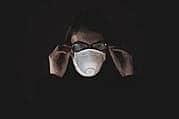
Have you Conducted Your Annual Fit Testing?
The OSHA Respiratory Protection Standard requires that respirator fit testing be performed initially (before the employee is required to wear a respirator), and it must be repeated at least annually when respirator use is required.
Fit testing must also be conducted whenever respirator design or facial changes occur that could affect the proper fit of the respirator. Examples of conditions that would require additional fit testing include the use of a different size or make of respirator, weight loss, cosmetic surgery, facial scarring, the installation of dentures, or the absence of dentures that are normally worn by the individual.
What is the purpose of fit testing? Fit testing confirms the correct fit of any respirator that forms a tight seal on the user’s face. This ensures that users are receiving the expected level of protection by minimizing contaminant leakage into the facepiece.
When a respirator doesn’t fit properly, a portion of the air breathed in can bypass the respirator’s filter and enter the breathing zone through breaks in the seal of the respirator along the face. Simply put, a respirator can’t protect if it doesn’t fit the employee’s face!
There are two types of fit testing methods: qualitative and quantitative.
Qualitative fit testing is a pass/fail test method that relies on a person’s sense of taste or smell or reaction to an irritant in order to detect leakage into the respirator facepiece. It is used commonly for fit testing N95 respirators. Qualitative fit testing does not measure the actual amount of leakage.
Whether the respirator passes or fails the test is based simply on detecting leakage of the test substance into the facepiece. There are four qualitative fit test methods accepted by OSHA:
- Isoamyl acetate, which smells like bananas
- Saccharin leaves a sweet taste in the mouth
- Bitrex™, which leaves a bitter taste in the mouth
- Irritant smoke, which can cause coughing.
Qualitative fit testing is used for half facepiece and full facepiece elastomeric respirators. Quantitative fit testing uses a machine to measure the actual amount of leakage into the facepiece and does not rely upon an individual’s sense of taste, smell, or irritation in order to detect leakage.
The respirators used during this type of fit testing will have a probe attached to the facepiece that is connected to the machine by a hose. There are three quantitative fit test methods accepted by OSHA:
- Generated aerosol
- Ambient aerosol and modified ambient aerosol
- Controlled negative pressure
As mentioned above, when respirator use is mandatory, fit testing is required initially and annually. However, because of the respirator and fit testing supply shortages during the COVID-19 pandemic, OSHA has issued several temporary enforcement guidance memoranda allowing for enforcement discretion related to certain provisions of the Respiratory Protection Standard including annual fit testing, if employers are showing good faith effort to comply with as many requirements of the Standard as possible.
However, when supply chain issues are resolved employers are expected to come into full compliance with the Standard.
Safety Partners is now offering qualitative fit testing as part of our EHS services! For help conducting your initial and annual fit testing, or for additional information about fit testing requirements, learn more here.
This blog was written by Beth Graham, our Associate Director of Quality, Research, and Training who has been with Safety Partners Inc. for the last 11 years.
